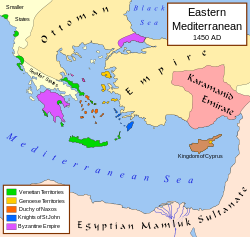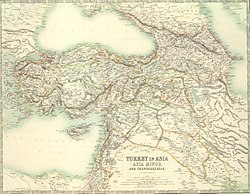Karamanids
Karamanoğlu | |||||||||
|---|---|---|---|---|---|---|---|---|---|
| 1250–1487 | |||||||||
|
Flag | |||||||||
 The Karamanid Emirate and other easter Mediterranean states in 1450 | |||||||||
| Capital | Larende Ermenek Konya Mut Ereğli [1] | ||||||||
| Common languages | Turkish | ||||||||
| Religion | Muslim | ||||||||
| Government | Monarchy | ||||||||
| Bey | |||||||||
• 1256? | Kerimeddin Karaman Bey | ||||||||
• 1483 – 1487 | Turgutoğlu Mahmud | ||||||||
| Historical era | Late Medieval | ||||||||
• Established | 1250 | ||||||||
• Disestablished | 1487 | ||||||||
| |||||||||
Beylik of Karaman or of Karamanoğlu (Karamanoğulları in Turkish plural), also called the Karamanid Dynasty or the Karamanids, was an Anatolian Turkish Beylik state centered in south-central Anatolia, around the present-day Karaman Province. From the 13th century until its fall in 1467, Karamanoğlu was one of the most powerful states in Anatolia.
History
The Karamanids traced their ancestry back to Hoca Sadeddin and his son Nure Sufi, who emigrated from Azerbaijan to Sivas. He moved from there to the western Taurus Mountains, near the town of Larende, where he worked as a woodcutter. Nure Sufi's son, Kerimeddin Karaman Bey, gained a tenuous control over the mountainous parts of Cilicia in the middle of the 13th century. A persistent but spurious legend, however, claims that the Seljuk Sultan of Rum, Kayqubad I instead established Karaman in these lands.[2]
Karaman expanded his territories by capturing castles in Ermenek, Mut, Ereğli, Gülnar, Mer, and Silifke. As a reward for this expansion of Seljuk territory, the sultan Kilij Arslan IV gave the town of Larende (now Karaman in honor of the dynasty) to the Karamanoğlu. In the meantime, Bunsuz, brother of Karaman Bey, was chosen as a bodyguard (Candar) for Kilij Arslan IV. Their power rose as a result of the unification of Turkish clans that lived in the mountainous regions of Cilicia with the new Turkish elements transferred there by Kayqubad.
Good relations between the Seljuks and the Karamanids did not last. In 1261, on the pretext of supporting Kaykaus II who had fled to Constantinople as a result of the intrigues of the chancellor Pervâne, Karaman Bey and his two brothers, Zeynül-Hac and Bunsuz, marched toward Konya, the capital of Seljuks, with 20,000 men. A combined Seljuk and Mongol army, led by the chancellor Mu'in al-Din Suleyman, the Pervane, defeated the Karamanoğlu army and captured Karaman Bey's two brothers.
After Karaman Bey died in 1262, his older son, Şemseddin Mehmet I, became the head of the house. He immediately negotiated alliances with other Turkmen clans to raise an army against the Seljuks. During the 1276 revolt of Hatıroğlu Şemseddin Bey against Mongol domination in Anatolia, Karamanoğlu also defeated several Mongol-Seljuk armies. In the Battle of Göksu in 1277 in particular, the central power of the Seljuk was dealt a severe blow. Taking advantage of the general confusion, Mehmed Bey captured Konya on 12 May and placed on the throne a pretender called Jimri who claimed to be the son of Kaykaus. In the end, however, Mehmed was defeated by Seljuk and Mongol forces the same year, and executed with some of his brothers.
Despite these blows, Karamanoğlu continued to increase their power and influence, largely aided by the Mamluks of Egypt, especially during the reign of Baybars. Karamanoğlu captured Konya on two more occasions in the beginning of the 14th century, but were driven out the first time by emir Chupan, the Ilkhanid governor for Anatolia, and the second time by Emir Chupan's son and successor Timurtash. An expansion of Karamanoğlu power occurred after the fall of the Ilkhanids. A second expansion coincided with Karamanoğlu Alâeddin Ali Bey's marriage to Nefise Sultan, the daughter of the Ottoman sultan Murad II, the first important contact between the two dynasties.
As Ottoman power expanded into the Balkans, Aleaddin Ali Bey captured the city of Beyşehir, which had been an Ottoman city. However, it did not take much time for the Ottomans to react and march on Konya, the capital city of Karamanids. A treaty between the two kingdoms was made and peace existed until the reign of Bayezid I.
Timur gave control of the Karamanid lands to Mehmet Bey, the oldest son of Aleaddin Ali Bey. After Bayezid died in 1403, the Ottoman Empire went into a political crisis. During this time, the Ottoman family fell prey to an internecine strife. It was an opportunity not only for Karamanoğlu, but also for all of the Anatolian beyliks. Mehmet Bey assembled an army to march on Bursa. He captured the city and damaged it; this would not be the last Karamanid invasion of Ottoman lands. However, Mehmet Bey was captured by Bayezid Pasha and sent to prison. He apologized for what he had done and was forgiven by the Ottoman ruler.
Ramazanoğlu Ali Bey captured Tarsus while Mehmet Bey was in prison. Mustafa Bey, son of Mehmet Bey, retook the city during a conflict between the Emirs of Sham and Egypt. After that, the Egyptian sultan sent an army to retake Tarsus from the Karamanids. The Egyptian Mamluks damaged Konya after defeating the Karamanids, and Mehmet Bey retreated from Konya. Ramazanoğlu Ali Bey pursued and captured him; according to an agreement between the two leaders, Mehmet Bey was exiled to Egypt for the rest of his life.
During the Crusade of Varna against the Ottomans in 1443-4, Karamanid İbrahim Bey marched on Ankara and Kütahya, destroying both cities. In the meantime, the Ottoman sultan Murad II was returning from Rumelia with a victory against the Hungarian Crusaders. Like all other Islamic emirates in Anatolia, the Karamanids were accused of treason. Hence, İbrahim Bey accepted all Ottoman terms. The Karamanid state was eventually terminated by the Ottomans in 1487, as the power of their Egyptian allies was declining.
Flag
According to the A. Cresques' Catalan Atlas of 1375, flag of Karamanoğlu consists of a blue 6-edged star[]. The flag of Karamanoğlu may be confused with Star of David, the Jewish symbol, used by Israel today. However, it is not a Jewish symbol. In medieval times, this star was also an Islamic symbol known as the Seal of Solomon (Suleiman) and was extremely popular amongst the Turkish Beyliks of Anatolia. The seal was also used by Ottomans in their mosque decorations, coins and personal flags of pashas, including that of Hayreddin Barbarossa.[1] Another state known to use the seal on their flag was the Candaroğlu.
Power of the Karamanid state in Anatolia
According to Mesâlik-ül-Ebsâr, written by Şehâbeddin Ömer, the Karamanid army had 25,000 riders and 25,000 saracens. They could also rely on some Turkmen tribes and their warriors.
Their economic activities depended mostly on control of strategic commercial areas such as Konya and the ports of Lamos, Silifke, Anamur, and Manavgat.
Karamanid architecture
66 mosques, 8 hammams, 2 caravanserais and 3 medreses built by the Karamanoğlu reached our day. Some among notable works of Karamanoğlu architecture are as follows:
- Hasbey Medrese (1241)
- Şerafettin Mosque (XIII century)
- İnce Minare (Dar-ül Hadis) Medrese (1258-1279)
- Hatuniye Medrese
List of rulers
- Nûre Sûfî Bey (Capital City: Ereğli) (1250-1256) [1]
- Kerîmeddin Karaman Bey (Capital City: Ermenek) (1256?-1261)
- Şemseddin I. Mehmed Bey (1261-1277)
- Güneri Bey (1283-1300)
- Bedreddin Mahmud Bey (1300-1308)
- Yahşı Han Bey (1308-1312) (Capital City: Konya)
- Bedreddin I. İbrahim Bey (1312-1333, 1348-1349)
- Alâeddin Halil Mirza Bey (1333-1348)
- Fahreddin Ahmed Bey (1349-1350)
- Şemseddin Bey (1350-1351)
- Hacı Sûfi Burhâneddin Musa Bey (Capital City: Mut) (1351-1356)
- Seyfeddin Süleyman Bey (1356-1357)
- Damad I. Alâeddin Ali Bey (1357-1398)
- Sultanzâde Nâsıreddin II. Mehmed Bey (Gıyâseddin)(1398-1399)
- Damad Bengi II. Alâeddin Ali Bey (1418-1419, 1423-1424)
- Damad II. İbrahim Bey (1424-1464)
- Sultanzâde İshak Bey (1464)
- Sultanzâde Pîr Ahmed Bey (1464-1469)
- Kasım Bey (1469-1483)
- Turgutoğlu Mahmud Bey (1483-1487)
Notes and references
- ^ a b Türk Tarih Sitesi, Türk Tarihi, Genel Türk Tarihi, Türk Cumhuriyetleri, Türk Hükümdarlar - Tarih
- ^ Claude Cahen, Pre-Ottoman Turkey: a general survey of the material and spiritual culture and history c. 1071-1330, trans. J. Jones-Williams (New York: Taplinger, 1968), 281-2.
- Mehmet Fuat Köprülü (translated by Gary Leiser (1992). The Origins of the Ottoman Empire ISBN 0791408191. State University of New York Press. (limited preview)
| History of Turkey |
|---|
 |
| Timeline |
|
|

